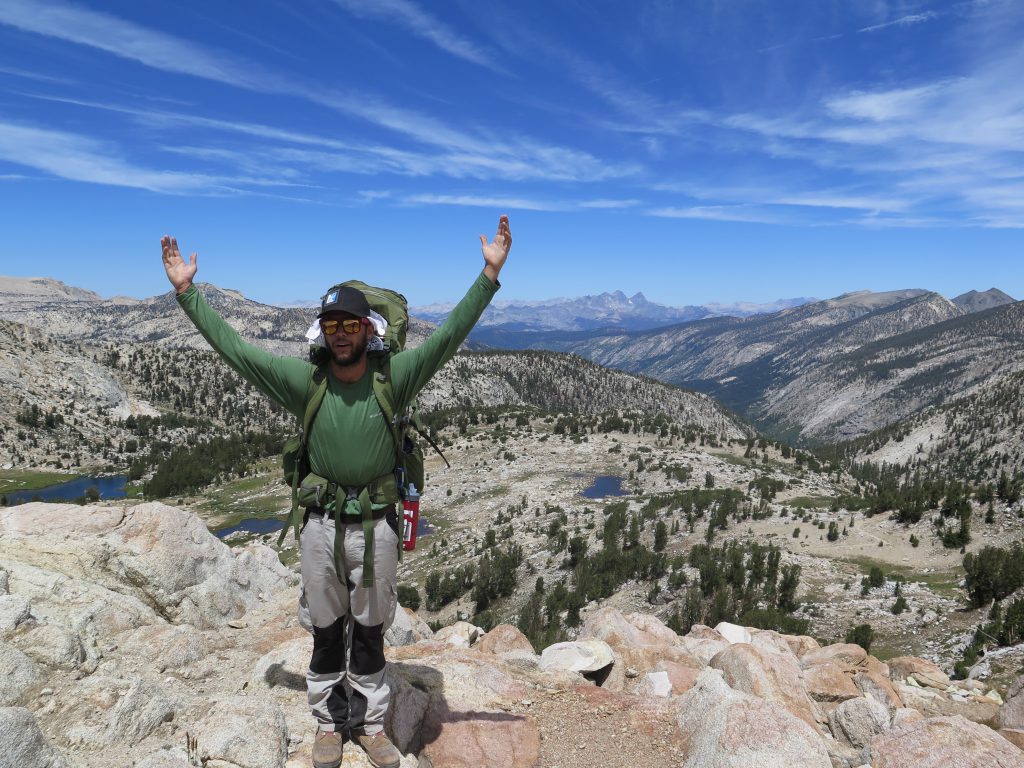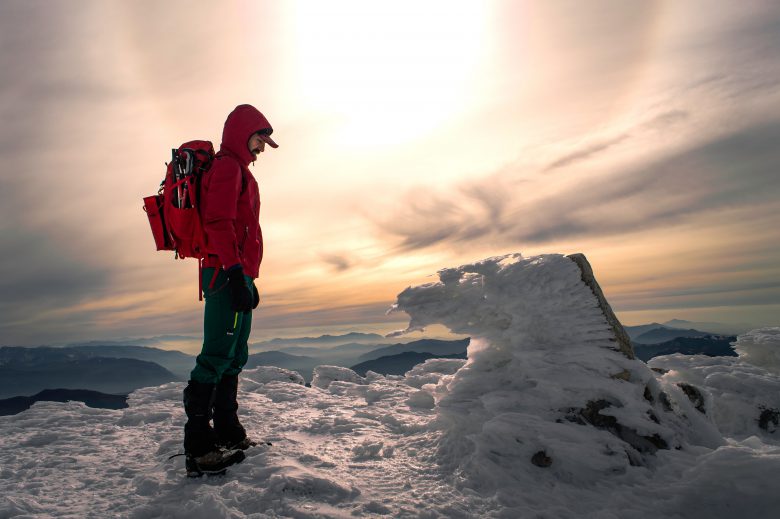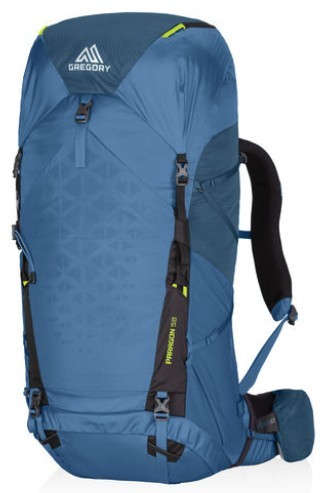Gregory is one of the few backpack manufacturers to develop a waist belt system that adjusts to fit different hip angles, which provides significant advantages in terms of load transfer. So, without further ado let’s dive into our Gregory Paragon Backpack review.
Article Overview
Gregory Paragon Backpack Overview
Pack Type: Gregory Paragon
Sizes Available: 38L, 48L, 58L, 68L
Gregory pioneered many of the industry’s first, including the first to build packs in a different frame, harness and waist belt sizes and the development of the center-locking bar tack, which is a stitch that ends and locks off on the center of a seam instead of the size for increased strength at major stress points.
History of Gregory Mountain Products
The history of Gregory backpacks began with a man named Wayne Gregory. Gregory, the company’s founder, designed his first backpack at the age of 14 as part of a Boy Scout project. He later met Andy Drollinger, the founder of San Diego California Adventure 16, at a boy scout camporee.
After their meeting, Wayne started hanging around Andy’s factory, buying raw materials, and experimenting with his own designs. He later became Adventure 16’s second employee.
Wayne officially founded Gregory Mountain Products, based in San Diego, California in 1977. From the beginning, Gregory has been committed to using quality materials in the construction of their packs. But perhaps more importantly, all of Gregory’s earliest packs were vigorously field-tested and these tests led to an important revelation: fit is king.
Gregory Paragon Backpack Specs
The Paragon series is available in a number of capacities. Depending on how must space you need, it’s available in sizes of 38, 48, 58, and 68 liters. Here’s a concise list of base weight and dimensions for each of these sizes:
Paragon 38L
Base Weight: 3.3 pounds
Dimensions (in inches): 27 x 13 x 10
Paragon 48L
Base Weight: 3.3 pounds
Dimensions (in inches): 29 x 13 x 10
Paragon 58L
Base Weight: 3.9 pounds
Dimensions (in inches): 31 x 13 x 10
Paragon 68L
Base Weight: 3.9 pounds
Dimensions (in inches): 31 x 13 x 12
Among industry-leading packs, the base weight of the Paragon isn’t necessarily in the top-tier. For reference, The Osprey Exos 48L pack offers a base weight of just 2.35 pounds. That said, many of the lightest packs on the market sacrifice comfort for weight. With Gregory’s commitment to fit and comfort, you can be sure this won’t be the case.
Finding Your Backpack Fit
Finding the right fit for your Gregory Backpack requires that you take two measurements of your body. The first measurement you’ll need is your waist circumference. Find your handy measuring tape and begin at your belly button, wrap around your back, and back to your belly button. Now the hardest part: don’t forget the number you just came up with!
Here’s a quick breakdown of which size pack you’ll be looking at depending on waist size:

Your choice won’t simply depend on your waist size though. The second measurement you’ll need to take might require a couple of additional hands. You’ll need to measure from the base of your spine up to that large bony prominence sticks out at the back of your neck. Depending on your measurement, here’s a breakdown of pack sizes according to torso length:
Small/Medium
15 to 18 inches
Medium/Large
19 to 22 inches
Now, what do you do if you’re in between sizes? When it comes to hip fit, it is typically recommended to size down if you find yourself in one of these “tweener” ranges. This will ensure that harness load lifters can still effectively lift pack weight onto the hip belt in order to function properly.
When it comes to fit, Gregory recommends sizing down if you have a slimmer upper body and size up if you have a broad upper body. Following this recommendation will help to ensure proper harness padding coverage.
Features of the Gregory Paragon Backpack
The Gregory Paragon Backpack series comes with a bevy of features. Not surprisingly, most of these features are designed to maximize your comfort.
It boasts sleeping pad multi-straps with a removable girth hitch. These straps can be used to carry your sleeping pad. The straps can also be removed to secure other items.
The pack’s Aerolon Suspension System is designed with a customized lightweight 7001 aluminum chassis. This suspension system stabilizes the pack’s weight load and reduces your energy expenditure on the trail.
A removable Sidekick daypack combines a reservoir sleeve with an ultralight daypack that can be removed for a summit hike or a supply run down into town.
The sunglass Quickstow system on the pack’s shoulder harness gives you a secure and scratch-free place to quickly stash your shades when rain hits on the trail.
And finally, solar-ready attachment points on the top pockets of the pack are compatible with Goal Zero portable solar panels.
Feedback From the Field
So let’s take a look at what some people who’ve used the Paragon backpack in the wilderness have said about its functionality. The first review I read pointed out that the pack is easy to carry and very comfortable, offers great capacity, and is best used for weekend trips.
Another review highlighted the pack’s ease of access to items and said they’ve been impressed with how the pack has held up on longer trips.
In terms of cons, one review did mention that the pack ripped easily. It is worth noting here, then, that the bottom panel of the Gregory Paragon series has been reinforced with dual-layer construction for abrasion, weather, and puncture resistance.
That feature, however, appears to be limited to the bottom panel of this pack. Overall, the Paragon Series received an average of 4 out of 5 stars in the reviews I read.
Share Your Experience!
As I’ll preach continually, two of the most important determining factors in choosing the right pack are: a) what are you primarily going to be using it for? and b) how much gear do you typically bring along for those types of trips? But as you’ll notice here, there’s certainly a third consideration: how does the pack fit and how does it feel?
After all, if you’re not comfortable on the trail, what’s the point? Backpacking should be fun and relaxing. It should allow you to disconnect from daily stresses and reconnect to the beauty of nature. The right pack will add to your enjoyment and make your experience that much less stressful!
About The Backpack Guide

At The Backpack Guide, I’m always looking for new trails and wildernesses to explore. I’m also excited to see and share photos of readers with their new backpacks. Please don’t hesitate to share your latest adventure or backpack purchase on social media by tagging @thebackpackguide on Instagram and Facebook!
I hope you’ve enjoyed this review and I’d love to hear your feedback in the comments section below. I’ll be quick to reply to any questions, comments, or concerns you feel like sharing!
See Ya Out There!
The Backpack Guide







Comments
A very interesting and extensive review of the Gregory Paragon backpack. I think that the field testing and customer reviews will make for a very good quality and the perfect fit. You talked about rain and then stashing your sunglasses: can I take it that these backpacks are water proof? How much weight can these packs take?
Author
Hi Jerry!
These packs come with a built-in rain cover when the weather turns south!
And to answer your question about weight, it’ll depend on which size pack you opt for, i.e. 38-liters, 48, 58, or 68. From experience, I’ll tell you’ll really be able to load a 68-liter pack down (70+ pounds), but this isn’t really all that fun! (Been there done that, don’t recommend it!)
A general rule is to make sure your pack weighs no more than 1/3 of your total body weight. So, if I weigh 150 pounds, I never really want to be carrying a pack that weighs more than 50 pounds.
Does that help?
Tucker